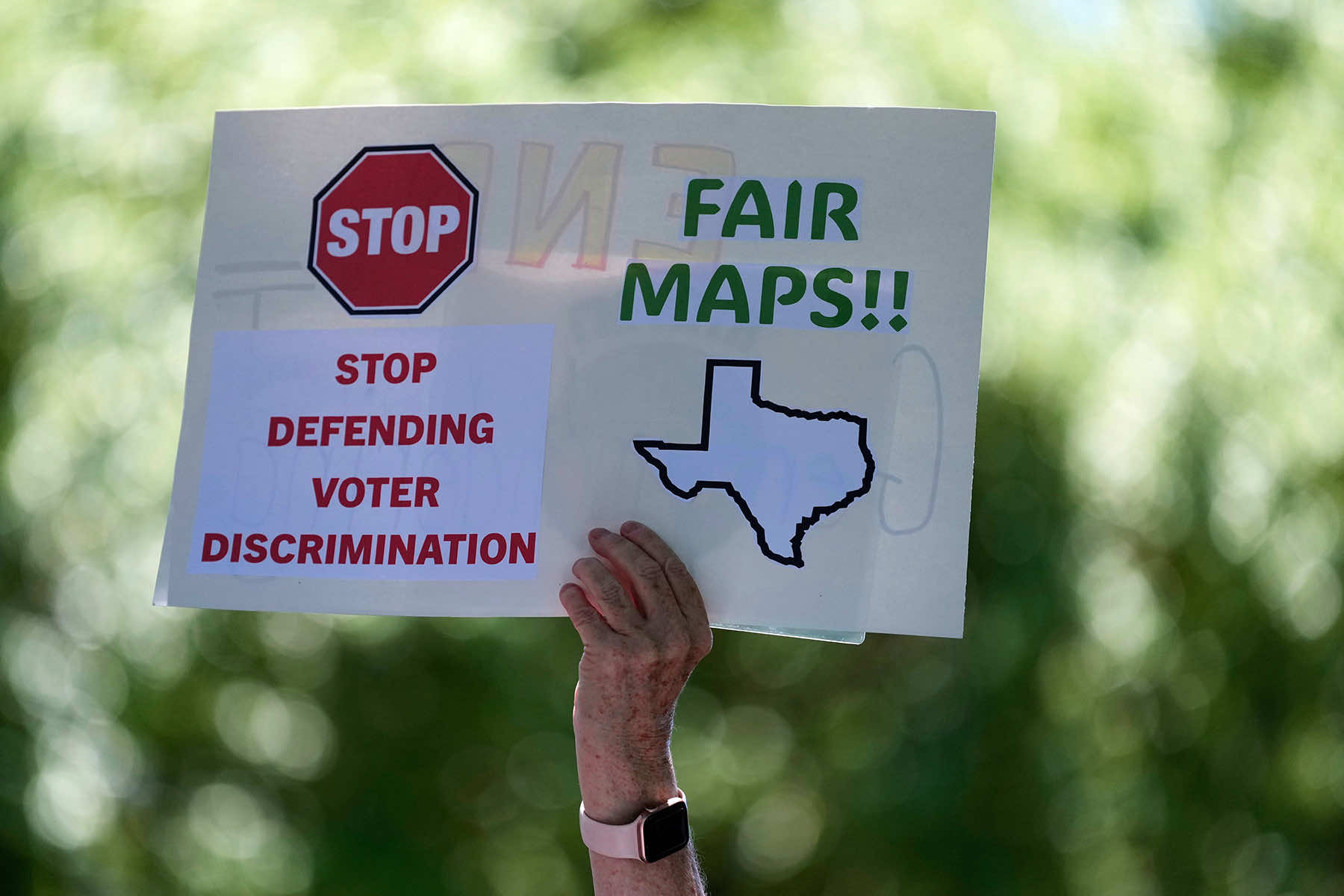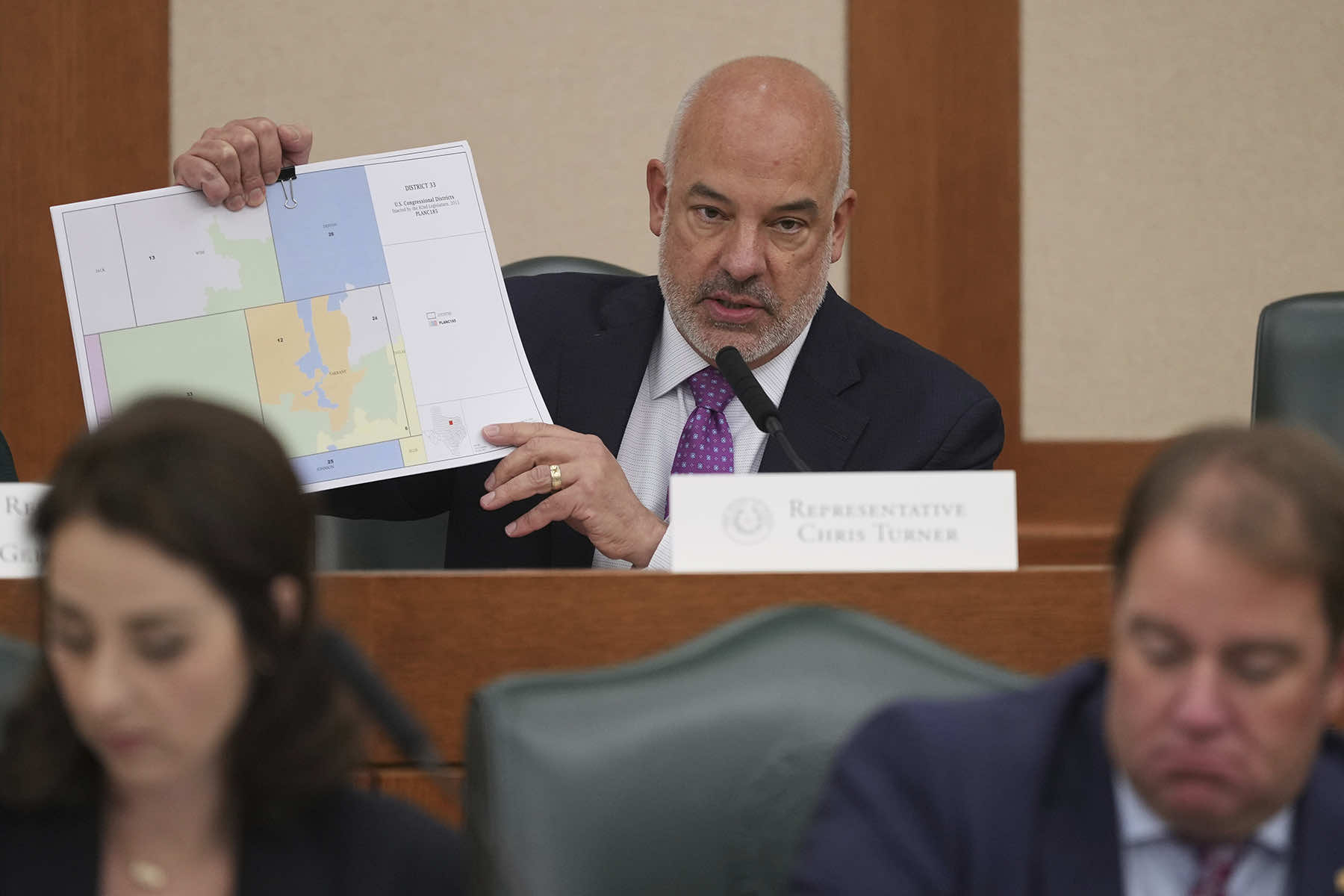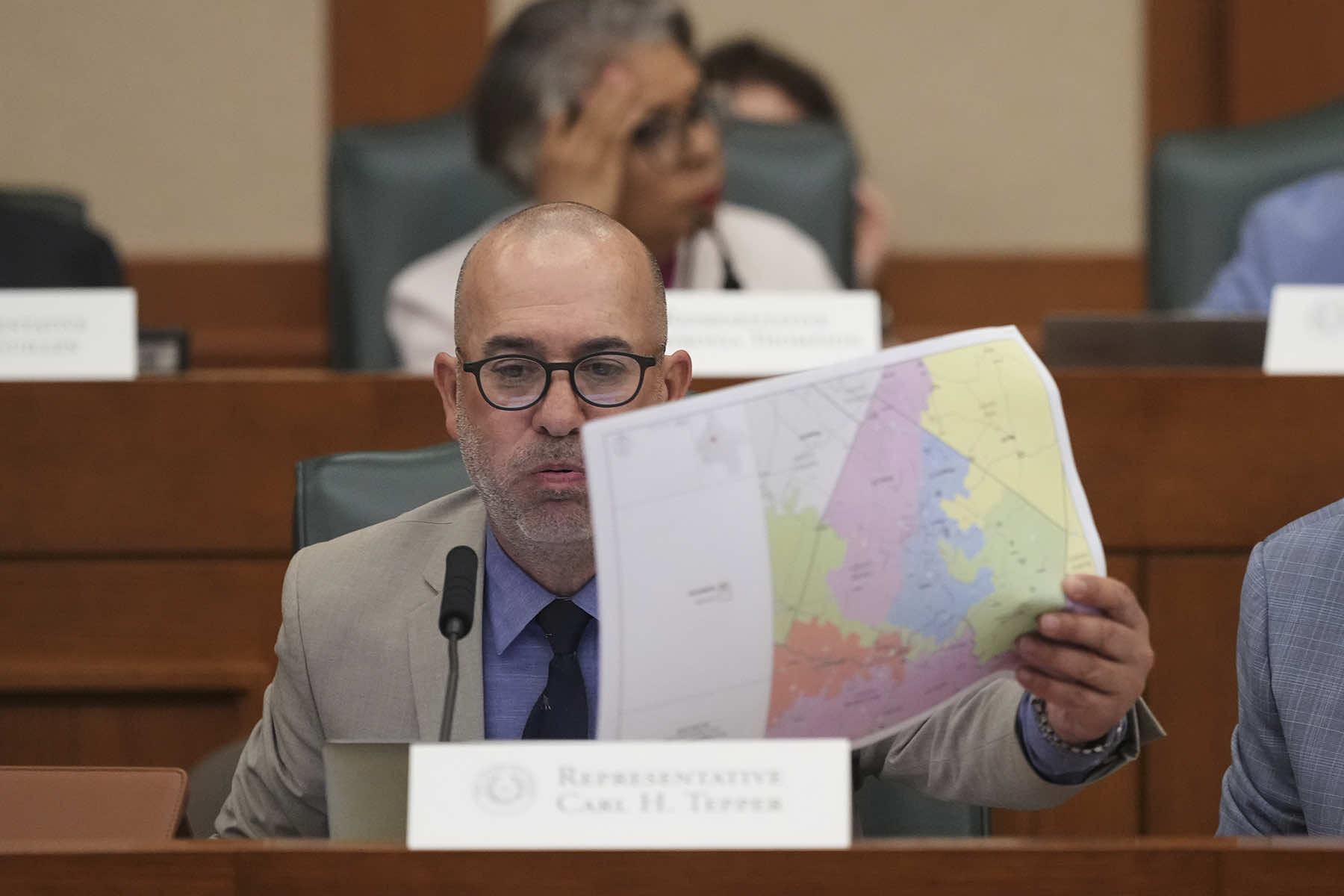
Republicans in the Texas legislature are working to redistrict the state before the 2026 midterm elections.
Although state legislatures normally redraw district lines every ten years after the census required by the Constitution, President Donald J. Trump has asked Texas Republicans to redistrict now, mid-decade, in order to cut up five districts that tend to vote Democratic and create districts Republicans will almost certainly win. Five additional seats will help the Republicans hold control of the House of Representatives despite their growing unpopularity.
Trump is urging other Republican-dominated state legislatures—those in Florida, Indiana, Missouri, New Hampshire, and Ohio, for example—to do the same thing. “We’re going to get another three or four or five, in addition,” Trump said to reporters about House seats. “Texas would be the biggest one, and that’ll be five.”
In response to the push, Democrats in Texas fled the state on August 3 to hinder Republicans from approving a new U.S. House map that could boost their slim congressional majority in 2026. The walkout lets the minority party keep Republicans in charge from having enough votes for maps that would add five new Republican-leaning congressional districts.
“We’re leaving Texas to fight for Texans,” Gene Wu, chair of the House Democratic Caucus, said in a statement on August 3. “We’re not walking out on our responsibilities. We’re walking out on a rigged system that refuses to listen to the people we represent.”
The Texas legislators traveled to Boston, Massachusetts, and to Albany, New York, to confer with Democratic leaders. About 30 of them, though, went to Chicago, Illinois, where Illinois governor J.B. Pritzker welcomed them.
“My Democratic colleagues and I have just left our beloved state to break quorum and stop Trump’s redistricting power grab,” Texas state representative James Talarico said in a video posted to social media. “Trump told our Republican colleagues to redraw the political maps here in Texas in the middle of the decade to get him five more seats and protect his majority in Congress. They’re turning our districts into crazy shapes to guarantee the outcome they want in the 2026 elections. If this power grab succeeds, they will hang on to power without any accountability from the voters. But Texas Democrats are fighting back. We’re leaving the state, breaking quorum and preventing Republicans from silencing our voices and rigging the next election. We are not fighting for the Democratic Party. We are fighting for the democratic process, and the stakes could not be higher. We have to take a stand.”
Other lawmakers around the country have used walkouts in similar situations. Democratic state senators from Wisconsin fled to neighboring Illinois in 2011, blocking a vote on GOP Governor Scott Walker’s plan to strip most public workers of their union rights. At the same time, pro-union protesters descended on the state Capitol. The stalemate ended several weeks later after Republicans weakened their legislation.
Shane Goldmacher and Nick Corasaniti of “The New York Times” noted that “[v]oters are … reduced almost to bystanders as Republicans essentially admit to trying to determine the outcome of Texas races long before the elections are held.”
A person close to the president told Goldmacher and Corasaniti that the White House strategy is “Maximum warfare, everywhere, all the time.”
Trump and the Republicans would not be trying to rig the system if they thought they could win a majority of voters.
Wu warned that the attempt to grab five new seats in Texas to maintain control of the U.S. House of Representatives against the will of voters is a threat not only to Texas, but to the entire country and to the concept of America.
“If Donald Trump is allowed to do this, if he is allowed to once again cheat and get away with it, there’s no stopping this. This will spread across the country, and…will occur everywhere. Because if one person’s going to cheat and no one’s going to stop it, why doesn’t everyone just do it then? And that is not a society, that is not an America that works.”
Wu continued: “Everyone is already tired of the hyperpartisan bickering and all the fighting because we never get anything done. And they are creating a system that will reinforce that and make it even worse. And we’re telling people, please come out, stand up against it, rise up and say no more. Enough.”
Wu said the Texas Democratic representatives “did not make the decision lightly, but we come here today with absolute moral clarity.”
Governor Pritzker has been in contact with the Texas Democrats to plan for such a moment. His staff will provide logistical support to the visiting Texans. Tonight he made it clear that the Texas Democrats’ fight against Trump’s power grab is the fight of all Americans to protect democracy. “Let’s be clear,” Pritzker said, “this is not just rigging the system in Texas. It’s about rigging the system against the rights of all Americans for years to come.”
Pritzker continued: “Texas Democrats were left no choice but to leave their home state, block a vote from taking place, and protect their constituents. This is a righteous act of courage.” Pritzker urged other Americans to “take a page from these leaders’s playbook. When you show people that you have the will to fight, well, they can muster the will to fight, too. Courage is contagious.”
“To be in public office right now is to constantly ask yourself, how do I make sure that we’re standing on the right side of history? There’s a simple answer. The wrong side of history will always tell you to be afraid. The right side of history will always expect you to be courageous. Expect courage from people around you, and it will show up. Expect fear, and fear will rule the day. Let the courage of these leaders be an example to the rest of the country. I’m proud to stand side by side with our friends from Texas today.”
Carving districts to either “crack” political opponents into different districts or “pack” them into a single district is called “gerrymandering,” after Elbridge Gerry, an early governor of Massachusetts who signed off on such a scheme (even though he didn’t like it). Parties have always engaged in gerrymandering, but computers make it possible to carve up districts with surgical precision.
The extreme gerrymander Texas Republicans are attempting is coming on top of partisan gerrymanders already in place. As journalist David Daley explained in his book Ratf**cked: The True Story Behind the Secret Plan to Steal America’s Democracy, after Democrat Barack Obama won the presidency in 2008, Republican operatives worked to make sure he had a hostile Congress that would keep him from passing legislation.
To push a plan they dubbed Operation REDMAP, which stood for Redistricting Majority Project, they raised $30 million, mostly from corporations, to buy ads and circulate literature that would convince voters to elect Republican state legislators in 2010. The legislatures elected in 2010 would get to redistrict their states with maps that would last for a decade.
The plan worked. After the 2010 election, Republicans controlled the key states of Florida, Wisconsin, North Carolina, Ohio, and Michigan, as well as other, smaller states, and they redrew congressional maps using precise computer models. In the 2012 election, Democrats won the White House decisively, the Senate easily, and a majority of 1.4 million votes for House candidates. But Republicans came away with a thirty-three-seat majority in the House of Representatives.
Gerrymandering does not just weight the scales of an election toward one political party, it also depresses turnout for the opposing party: if you know your candidate is going to lose, why bother to vote? (In one heavily gerrymandered North Carolina district in 2024, Democratic candidate Kate Barr worked to call attention to gerrymandering by using the campaign slogan: “Kate Barr Can’t Win.”) Sometimes the opposing party doesn’t even bother to run a candidate.
Meanwhile, the party with a lock on the district gets more radical, as candidates have to worry about being primaried by someone more extreme than they are, rather than about attracting centrist voters that in a fair district they might lose to an opposing party’s candidate.
Trump is also confronting his unpopularity by trying to cement his power in the federal courts. Republicans began working to cement their power by stacking the courts during Ronald Reagan’s presidency. Reagan’s attorney general, Edwin Meese, deliberately politicized the Department of Justice in an attempt, as he said, to “institutionalize the Reagan revolution so it can’t be set aside no matter what happens in future presidential elections.”
On July 20, Trump demanded the Senate abandon its longstanding tradition of so-called blue slips, an informal process by which a senator from the minority party can effectively block a judicial nominee proposed for their state. While this system can be abused by senators holding seats open for a president of their party—as Senator Josh Hawley (R-MO) did during the Biden administration—it is designed to prevent a president from stashing unqualified or bad appointees in their states.
Benjamin S. Weiss of Courthouse News noted that Democratic New Jersey senators Cory Booker and Andy Kim used the system to prevent Trump’s lawyer and advisor Alina Habba from consideration to be the U.S. attorney for the District of New Jersey.
After posting on social media that the practice means “the president of the United States will never be permitted to appoint the person of his choice,” Trump demanded that Senator Chuck Grassley (R-IA), the chair of the Senate Judiciary Committee, end the system “IMMEDIATELY, and not let the Democrats laugh at him and the Republican Party for being weak and ineffective.” Trump then reposted other posts calling Grassley a “RINO”—or Republican In Name Only—and “sneaky” and suggesting he hates America.
Ending the practice would effectively cut senators in the minority from any influence at all on judicial appointments, and Grassley, who has gotten Trump’s many controversial appointees through Senate confirmation, has refused to agree. He said: “I was offended by what the president said, and I’m disappointed it would result in personal insults.”
In July, Trump demanded the Senate cancel its scheduled August break and long weekends to confirm his “incredible nominees.” Democrats have deployed the same techniques Republicans used to slow the confirmation of Democratic presidents’ nominations.
According to Manu Raju and Victoria Stracqualursi of CNN, Senate minority leader Chuck Schumer (D-NY) said he would agree to let some nominees go through quickly in batches so the senators could go home, but only if the administration unfroze the federal funds Congress appropriated for agencies like the National Institutes of Health and programs like foreign aid, and only if Trump agreed he would not push for another rescissions package clawing back appropriations Congress passed.
Tonight, Trump posted: “Tell Schumer, who is under tremendous political pressure from within his own party, the Radical Left Lunatics, to GO TO HELL! Do not accept the offer, go home and explain to your constituents what bad people the Democrats are, and what a great job the Republicans are doing, and have done, for our Country. Have a great RECESS and, MAKE AMERICA GREAT AGAIN!!!”
Schumer reposted Trump’s rant and commented: “The Art of the Deal.”
Meanwhile, Democrats say they will fight back against Republican gerrymandering. They will challenge any Republican redistricting in court, but after standing firm on democratic institutionalism in the past, they now say they are willing to fight fire with fire and redistrict their own states to create Democratic districts.
What the Republicans are doing “is so un-American, and it’s a constant threat to our democracy,” Wisconsin governor Tony Evers said. “So I’m really pissed, frankly, and we are going to do whatever we can do to stop this from happening.”
Governors Kathy Hochul of New York and Pritzker are weighing options for redrawing maps in their own states. This will be more difficult for them than for Republican states because Democratic states tend to use independent citizen-led redistricting commissions rather than partisan systems.
California governor Gavin Newsom posted on social media: “[Trump] is so scared of the American people holding him accountable for his catastrophic actions, he wants Republicans to rig the 2026 elections for him.” Newsom pointed out that it would be easy for California to eliminate its Republican-leaning districts altogether, getting rid of nine Republican seats.
He posted on social media: “Game on.”
Eric Gay (AP) and Mark Black (AP)
Letters from an Аmerican is a daily email newsletter written by Heather Cox Richardson, about the history behind today’s politics

















